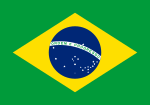1952 in Brazil
| 1952 in Brazil |
|---|
| Flag |
 21 stars (1889–1960) |
| Timeline of Brazilian history |
| Second Brazilian Republic |
| Year of Constitution: 1946 |
Events in the year 1952 in Brazil.
Incumbents
Events
- 4 March - Anchieta rail disaster: A crowded steam-powered passenger train derails while crossing a bridge over the Pavuna River near Anchieta station,[1] sending two old wooden carriages broadside onto the adjacent line. A modern high-speed electric freight train travelling in the opposite direction ploughs into the wooden carriages, telescoping them upwards. The severity of the accident was compounded by the fact that the suburban train is overloaded, with passengers clinging to the sides, underneath and between the carriages. A witness says they saw "passengers flying in all directions when the crash occurred". 119 people are killed and the resulting outcry prompts major new investment in Brazilian railways.
- 28 April - Pan Am Flight 202 crashes in the Amazon Basin approximately 220 nautical miles (410 km) southwest of Carolina, Brazil. All 50 people on board are killed in the worst-ever accident involving the Boeing 377.[2]
- 19 July - Brazil at the 1952 Summer Olympics: A team of 97 competitors attends the Games in Helsinki, Finland.
- 12 August - 1952 Transportes Aéreos Nacional Douglas C-47 mid-air explosion: A Douglas C-47A registered PP-ANH is destroyed after a in-flight fire causes it to crash near Palmeiras de Goiás. All 24 people on board are killed.[3]
- 14 December - The city of Paranavaí is founded.
- ‘’date unknown’’ – Bob's, Brazil’s first fast food chain, opens in Rio de Janeiro.
Arts and culture
Films
- O Canto do Mar, directed by Alberto Cavalcanti.
- Sai da frente, film debut of Amácio Mazzaropi.
- Tico-Tico no Fubá, directed by Adolfo Celi, starring Anselmo Duarte and Tônia Carrero.[4]
Music
- João Gilberto - "Quando Ela Sai"[5]
Television
- Sítio do Pica-pau Amarelo, written by Tatiana Belinky and based on the series of novels of same name by Monteiro Lobato.[6]
Births
- 18 January - Túlio Mourão, pianist and composer
- 17 August - Nelson Piquet, racing driver
- 19 August - Milton Hatoum, writer
- 10 September - Paulo Betti, actor
- 24 October - Ney Rosauro, percussionist and composer
- 25 December - Luiz Carlos de Carvalho Teixeira de Freitas, journalist, psychologist and writer
Deaths
- 2 February - João Guilherme Fischer agronomic engineer (born 1876)
See also
References
- ^ The Times, March 5, 1952, page 4
- ^ Accidents and Incidents involving the Boeing 377. Retrieved 23 October 2013.
- ^ Germano da Silva, Carlos Ari César (2008). "Palmeiras de Goiás". O rastro da bruxa: história da aviação comercial brasileira no século XX através dos seus acidentes 1928–1996 (in Portuguese) (2 ed.). Porto Alegre: EDIPUCRS. pp. 118–125. ISBN 978-85-7430-760-2.
- ^ "Festival de Cannes: Tico-Tico no Fubá". festival-cannes.com. Retrieved 2009-01-18.
- ^ Castro, Ruy (trans. by Lysa Salsbury). "Bossa Nova: The Story of the Brazilian Music That Seduced the World." 2000. 1st English language edition. A Capella Books, an imprint of Chicago Review Press, Inc. ISBN 1-55652-409-9 First published in Brasil by Companhia das Letras. 1990.
- ^ http://www.teledramaturgia.com.br/tele/sitio_tupib.asp
